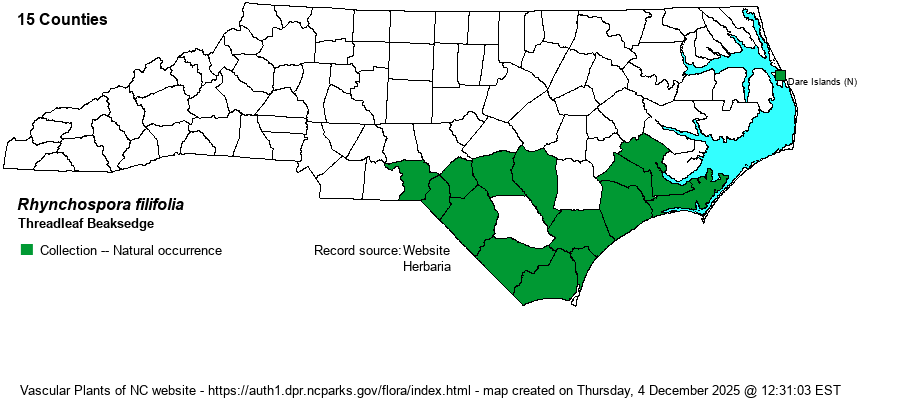| Author | A. Gray | |
| Distribution | Southern half of the Coastal Plain; scarce in the Sandhills (Fort Bragg). The Dare County specimen came from Roanoke Island.
Coastal Plain, NJ to central FL and eastern TX; Cuba, Mex., Belize, Nicaragua. | |
| Abundance | Frequent in the Coastal Plain, but rare in the Sandhills; disjunct to Dare County. Seemingly truly absent in the northern half of the Coastal Plain, as VA has only two historical county records. It does range sparingly north to NJ. The website editors suggest a State Rank of S3. | |
| Habitat | Carolina bays, natural depression ponds, depression meadows, and vernal pools. All sites experience moderate hydroperiods of inundation and drying out. Many sites have a Pond Cypress (Taxodium ascendens) canopy. Also occurs in some wet pine savannas. | |
| Phenology | Flowering and fruiting July-September. | |
| Identification | NC has two similar, skinny beaksedges of Carolina bays and natural depression ponds: this one and R. perplexa. The latter differs in the horizontal ridges on the seeds and a short blunt beak, versus smooth seeds and a long sharp beak in R. filifolia. | |
| Taxonomic Comments | None
Members of the genus Rhynchospora -- mainly called beaksedges but also called beakrushes -- are mostly Coastal Plain in distribution and are important members of our longleaf pine savannas, flatwoods, streamheads, depression ponds, Carolina bays, and beaver ponds. They vary from small and wiry to large and coarse. Keys concentrate on features of the achenes (seeds) and the shape and arrangement of the flower clusters (spikelets). The seeds may or not have bristles at their base; bristle number, length, and toothing are critical characters. Size and shape of the seed beaks is also critical. The drawings in Godfrey & Wooten (1979) are extremely helpful. The genus now includes Dichromena, the white-topped sedges. | |
| Other Common Name(s) | None | |
| State Rank | S2? [S3] | |
| Global Rank | G5 | |
| State Status | | |
| US Status | | |
| USACE-agcp | FACW link |
| USACE-emp | FAC link |

